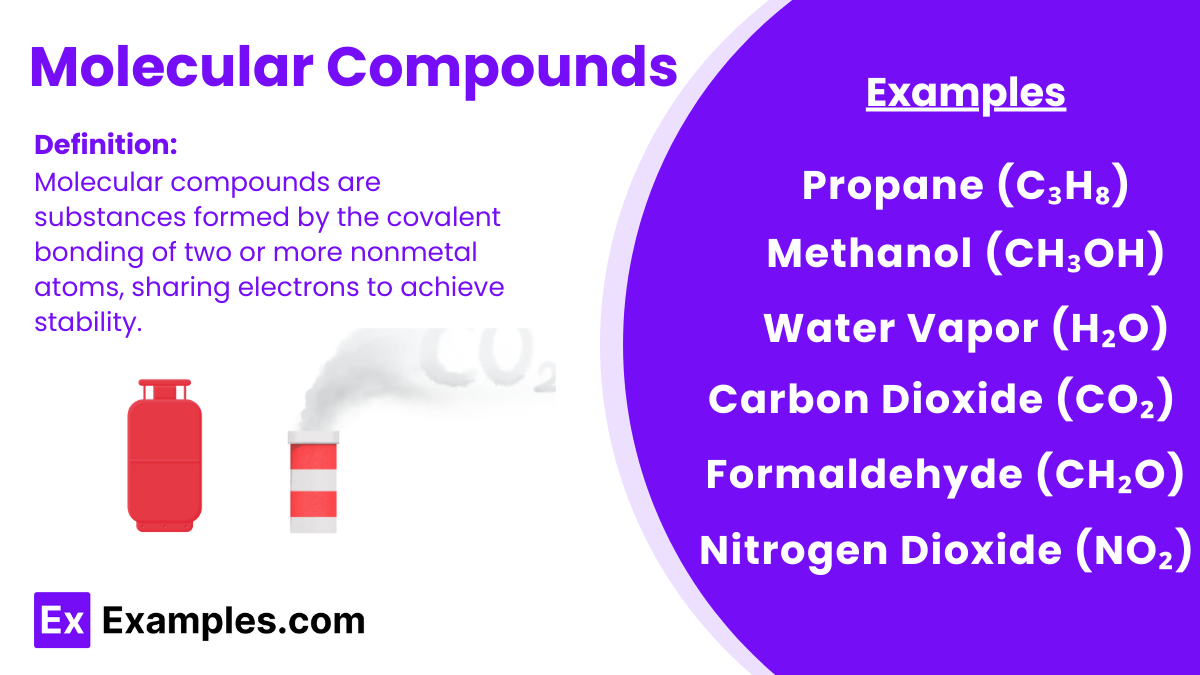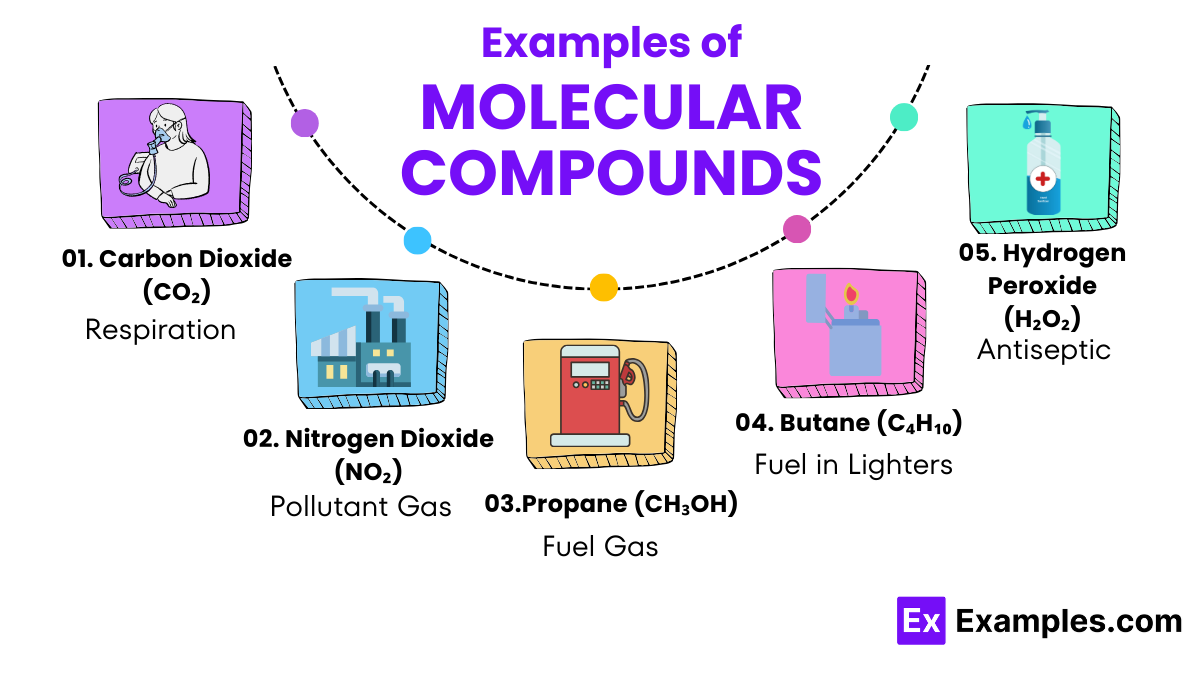What is a molecular compound?
A compound composed of ions
A compound composed of covalently bonded atoms
A compound composed of metallic elements
A compound composed of isotopes

Molecular compounds are substances formed when two or more atoms join together through chemical bonds. These atoms can be from the same element, like oxygen gas (O2), or different elements, such as water (H2O), where hydrogen and oxygen atoms bond together. What makes molecular compounds special is that they are usually formed between non-metal elements. In these compounds, atoms share electrons to achieve a stable electron arrangement, which we call covalent bonding. This sharing allows them to stick together and form the wide variety of substances we encounter in our daily lives, from the air we breathe to the water we drink.
Molecular compounds are chemicals where atoms of two or more non-metal elements bond together by sharing electrons, creating what we call covalent bonds. This process allows each atom to achieve a full outer shell of electrons, making the molecule more stable. Unlike ionic compounds, which involve the transfer of electrons between a metal and a non-metal, molecular compounds involve a mutual sharing of electrons. They can form a vast array of substances, from the water we drink (H2O) to the carbon dioxide (CO2) we exhale. These compounds are the building blocks of many materials in our natural world, and understanding them helps us grasp how various substances interact at a molecular level.
The structure of molecular compounds revolves around how atoms bond together to form molecules. At the heart of these structures are covalent bonds, where atoms share electrons to fill their outer shells, achieving stability. Imagine two friends holding hands, each representing an atom; their clasped hands symbolize the shared electrons. This sharing leads to the creation of a stable unit. The arrangement of these atoms in a molecule can vary, resulting in different shapes and sizes for each compound. For example, water (H2O) has a bent shape, while methane (CH4) forms a tetrahedral structure.
A molecular formula tells us the exact number and types of atoms present in a molecular compound. It’s like a recipe that shows the ingredients (atoms) and their quantities needed to make a molecule. For example, the molecular formula for water is H2O, which means each molecule of water is made up of two hydrogen atoms and one oxygen atom. Similarly, carbon dioxide’s formula is CO2, indicating one carbon atom bonded to two oxygen atoms. These formulas are essential for chemists because they provide a clear picture of a compound’s composition, helping us understand how substances react with each other, how they can be created or broken down, and what properties they might have. Learning to read and write these formulas is a fundamental skill in chemistry that opens the door to exploring the molecular world.

Start by identifying the elements present in the compound. For example, in CO₂, the elements are carbon (C) and oxygen (O).
Use prefixes to indicate the number of atoms of each element. These prefixes include mono- (1, often omitted for the first element), di- (2), tri- (3), tetra- (4), penta- (5), and so on. For CO₂, carbon doesn’t need a prefix, and oxygen uses di-, making it carbon dioxide.
Write the name of the first element as it appears on the Periodic Table. If there is more than one atom of the first element, add the appropriate prefix (except mono-). For example, in P₂O₅, the first element, phosphorus, has two atoms, so it’s diphosphorus.
For the second element, use the root name of the element and add the suffix “-ide.” In the P₂O₅ example, oxygen becomes oxide, making the full name diphosphorus pentoxide.
Put the names of the two elements together, with the prefixes in front to indicate the number of atoms. Thus, P₂O₅ becomes diphosphorus pentoxide, and CO becomes carbon monoxide.
Be aware of common names that might not follow these rules exactly, such as water (H₂O) not being commonly called dihydrogen monoxide in everyday language.
| Property | Description |
|---|---|
| Low Melting Point | Molecular compounds often melt at lower temperatures compared to ionic compounds. |
| Low Boiling Point | They generally boil at lower temperatures, making them often gases or liquids at room temperature. |
| Poor Conductivity | In their solid or liquid state, molecular compounds usually do not conduct electricity well. |
| Insoluble in Water | Many are insoluble or only partially soluble in water, though this can vary widely. |
Molecular compounds typically have low melting points. This is because the forces holding the molecules together are relatively weak compared to the ionic bonds in ionic compounds, requiring less energy to break.
Similar to melting points, molecular compounds also have low boiling points. The weak intermolecular forces make it easier for molecules to escape into the gas phase.
Molecular compounds do not conduct electricity well in their solid or liquid states. This is because they do not have free ions or electrons that move to conduct an electrical current.
Many molecular compounds do not dissolve well in water. Their molecular structures do not easily separate in water’s polar environment. However, there are exceptions, especially for compounds that can form hydrogen bonds with water.
Molecular compounds have distinct features that set them apart from other types of compounds. Here’s a look at some key characteristics:
Molecular compounds are formed by the sharing of electrons between atoms. This covalent bonding results in a strong connection between the atoms within a molecule but not between the molecules themselves.
Due to the weaker forces (van der Waals forces) between their molecules, molecular compounds often have lower melting and boiling points compared to ionic compounds. This means many of them are gases or liquids at room temperature.
In both solid and liquid forms, molecular compounds usually do not conduct electricity. This is because they lack free ions or electrons that are necessary for conducting electric current.
Many molecular compounds are more soluble in nonpolar solvents than in water. Their molecular structure tends to dissolve better in solvents with similar nonpolar characteristics.
Molecular compounds can undergo a wide range of chemical reactions. Their reactions are often determined by the specific elements involved and the arrangement of electrons in the covalent bonds.
| Feature | Ionic Compound | Molecular Compound |
|---|---|---|
| Bond Type | Formed by the transfer of electrons. | Formed by the sharing of electrons. |
| Conductivity | Conducts electricity when dissolved in water or melted. | Poor conductor of electricity in any state. |
| Melting and Boiling Points | High melting and boiling points. | Generally low melting and boiling points. |
| State at Room Temperature | Usually solid. | Can be gases, liquids, or solids. |
| Solubility | Soluble in water. | Soluble in nonpolar solvents, less so in water. |
| Examples | Sodium chloride (NaCl), Magnesium oxide (MgO). | Carbon dioxide (CO₂), Water (H₂O). |
Molecular compounds are ubiquitous, making up the majority of substances we encounter daily. They are primarily found in living organisms, where they play crucial roles in biological processes. For instance, water (H₂O), vital for all forms of life, is a molecular compound. These compounds are also abundant in the atmosphere; gases such as nitrogen (N₂) and oxygen (O₂) are essential for life on Earth. In addition, molecular compounds are key components in foods, medicines, and plastics, showcasing their widespread presence in both natural and synthetic materials. Their versatility and varied properties mean that molecular compounds are integral to numerous industrial processes, including manufacturing, energy production, and pharmaceuticals, illustrating their importance across multiple sectors.
Each of these substances highlights the diverse roles molecular compounds play in the environment, technology, and health. From sustaining life to serving as fundamental building blocks in industrial applications, their impact is profound and far-reaching.
Molecular compounds are typically formed from non-metal elements. The most common element found in these compounds is carbon, known for its ability to form a wide variety of chains and rings. Carbon’s versatility makes it the backbone of organic chemistry, which studies compounds that primarily contain carbon-hydrogen (C-H) bonds. Another essential element in molecular compounds is hydrogen, which bonds with carbon and other non-metals to form a vast array of substances, from simple molecules like water to complex polymers and biological macromolecules. Together, carbon and hydrogen form the foundation of organic molecules, crucial for life and numerous synthetic materials. Other non-metals, such as oxygen, nitrogen, sulfur, and phosphorus, frequently combine with carbon and hydrogen to create a wide range of molecular compounds, each with unique properties and applications.
Text prompt
Add Tone
10 Examples of Public speaking
20 Examples of Gas lighting
What is a molecular compound?
A compound composed of ions
A compound composed of covalently bonded atoms
A compound composed of metallic elements
A compound composed of isotopes
Which of the following is a molecular compound?
NaCl
H₂O
Fe₂O₃
MgO
What type of bond is found in molecular compounds?
Ionic bond
Metallic bond
Covalent bond
ydrogen bond
Which of the following is a property of molecular compounds?
High melting points
Good electrical conductivity
High solubility in water
Low melting and boiling points
Which of the following molecular compounds is a polar molecule?
O₂
N₂
HCl
CH₄
What type of molecular shape does methane (CH₄) have?
Linear
Bent
Trigonal planar
Tetrahedral
Which of the following is a diatomic molecular compound?
CO₂
H₂O
N₂
CH₄
What is the bond angle in a water (H₂O) molecule?
90 degrees
104.5 degrees
120 degrees
180 degrees
What is the common name for the molecular compound NH₃?
Methane
Ammonia
Ethanol
Nitric acid
Which molecular compound is a major component of natural gas?
Methane
Propane
Ethane
Butane
Before you leave, take our quick quiz to enhance your learning!

